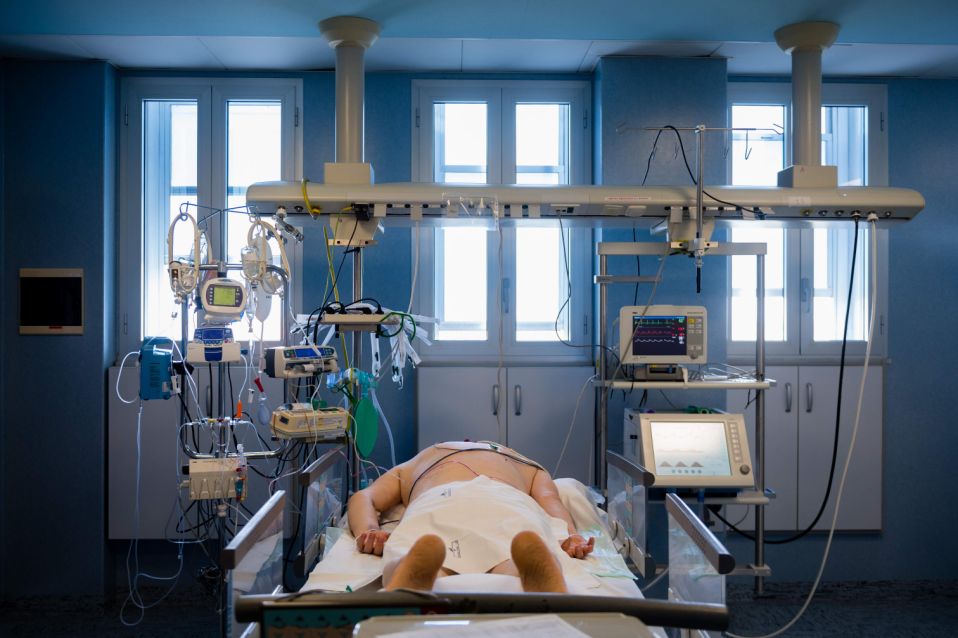
Doctors have begun using a technique called "proning," or shifting patients on their stomach, to prevent serious illness from the coronavirus. Here, a patient with COVID-19 in an Italian hospital. (Photo: Marco Mantovani/Getty Images)
Yahoo News/
More than one million people have recovered from the coronavirus, according to data from the Johns Hopkins University, a marker of success that can be traced to various factors. Ventilators, experimental drug treatments and a better understanding of the virus all have surely helped saved many lives.
But there’s an even simpler solution that’s quietly being implemented in emergency rooms across the globe, one that doctors say could be saving countless lives: proning.
Proning, a technique that involves having patients lie on their stomach, is actually more complex than it sounds, requiring six people to pull off safely. A well-known method in intensive care units, it’s long been used to improve the breathing of those suffering from acute respiratory distress syndrome (ARDS). Now being used in many ERs, it’s proving to be a low-risk, highly effective way to improve the breathing of COVID-19 patients early on — and prevent many from having to be put on ventilators.
According to one resident at an emergency room in Chicago (who requested anonymity because of his job), his team is now “proning as much as possible” with COVID-19 patients. While it may seem puzzling that simply being on your stomach could improve oxygen flow, the resident explains why it’s highly effective.
“When we’re laying on our backs, our diaphragm is pushed up by our abdominal organs and our lungs don’t expand as much as they could, especially the back part of our lungs,” he tells Yahoo Life. “When we prone patients … you’re allowing the diaphragm to sink low, because the abdominal organs are kind of falling with gravity, which allows the lungs to expand further and allows the back part of the lungs, which are normally being compressed when you’re on your back to expand more, to allow for ventilation. So you’re basically opening up more of the lungs to participate in gas exchange.”
Bryan Broderick, MD@BBroderickMD
1/21 After caring for patients in the ICU with #COVID for the last week, the time seems right for a #pulmonology #tweetorial on #Proning or #PronePositioning @sanjayvdesai @OslerResidency @JHUPCCMFellows @CPSolvers @thecurbsiders @cardionerds @tony_breu @david_furfaro @chadhoc

The rise of this technique in New York City, the epicenter of the U.S. outbreak, can be traced to Dr. Nicholas Caputo, associate chief of the ER department at Lincoln Medical Center in the Bronx, one of the hardest-hit hospitals in the nation. Caputo says that when COVID-19 patients first began flooding the hospital’s critical care units in early March, proning was not part of the protocol.
The Proning Team in action on critical care saving lives. Another example of great teamwork and staff working above and beyond. @BHR_hospitals #nhs


107Twitter Ads info and privacy35 people are talking about this
“The sort of paradigm at the time was to intubate early,” Caputo tells Yahoo Life. This made sense for patients who were clearly experiencing respiratory distress. The problem was, many patients arriving to the ER weren’t clearly in distress — they were experiencing what’s referred to as “silent hypoxics,” or breathing trouble with no symptoms. This means that despite appearing normal, their oxygen saturation level, or the amount of oxygen in the blood (normally between 95 and 100) has fallen sharply.
“These people would be on their cellphones, or just having a conversation, [seemingly fine but] with oxygen saturation in the 70s, 60s or even 50s. … These patients were getting intubated because everybody didn’t know how to approach them,” says Caputo. “So nurses were freaking out, doctors were puzzled and it was chaos.”
Given the high mortality rate of those put on ventilators, Caputo and his team began thinking of other options to prevent having to take that step. Inspired by a study conducted in Italy in late January in which physicians there showed positive results from proning COVID-19 patients, they began to try it. “We thought maybe that would help, so we started proning in the emergency department pretty early on.”
Within minutes of turning patients with low oxygen saturation on their stomachs, they saw oxygen saturation levels jump back into the normal range. “Patients who were coming in with oxygen stats in the 70s … once we proned them, after about a few minutes, they’d be up in the low 90s,” says Caputo. “That sort of brought the temperature down in the room, we could kind of take a step back and breathe.”
Rush University System for Health✔@RushMedical
Checking in with Rush’s interdisciplinary proning team. “I think we are all excited to be part of something this is so groundbreaking and is saving lives,” writes team member Sadie Finke, PT.

Caputo immediately began tracking the progress, publishing the first clinical report of the progress on April 22. The report showed that proning improved the oxygen saturation levels among 50 individuals with COVID-19 — some of whom had oxygen saturation levels as low as 69. After five minutes of proning, the mean oxygen saturation level was 94.
The technique soon spread in New York, Caputo says, which he believes is one of the reasons that the seriousness of infections has decreased. “I’ve heard from physicians around the world, they’ve been trying this and they’ve been having pretty good success with improving oxygenation and holding off on intubating patients,” he says. “And I think the numbers within New York City back that up. Late March, early April, we were intubating several hundred patients a day; then we started doing this and it caught on in the rest of the city, that number dropped to a few dozen a day.”
Caputo is careful to note that the technique is not perfect. Not everyone in his clinical review responded the same way. But overall, he hopes it is something that emergency rooms continue to adopt nationwide. “It’s not a panacea, it’s not a cure-all,” he says. “But it’s a way to buy time for some patients, and other patients, it’s a way to prevent intubation — cause we know this: If you get intubated, your odds of having a poor outcome in terms of mortality is around 50 per cent.”
Read More:





